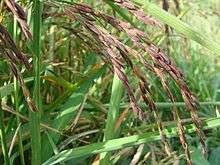Riceberry

Riceberry(Thai: ข้าวไรซ์เบอร์รี่) is a newly registered rice variety from Thailand originated from a cross-breed between Jao Hom Nin (JHN), the local non-glutinous purple rice and Khoa Dawk Mali 105(Jasmine rice), the Thai Hom Mali Rice, by Rice Science Center, Kasetsart University, Thailand. From 4 years of strenuous selection for nutritional properties, anthocyanin stability, physical and cooking properties. The outcome is the deep purple whole grain rice with softness and palatable after taste. Riceberry has been the most popular brown rice known for health promoting properties. Attracting people to consume more brown rice is the most significant steps in solving food-related chronic diseases like diabetes, heart disease, high blood cholesterol, obesity and cancers.[1]
Production and cultivation
The areas of Riceberry rice production are in the Northern and North-East of Thailand. During the months of August to December (wet season) is suitable for Riceberry planting. Table Agronomic characteristics, grain quality and cooking quality of Riceberry [1]
| Characteristics | |
|---|---|
| Plant height | 105–110 cm |
| Day of maturity | 130 |
| Yield (kg/ha) | 1875 - 3125 |
| grain length | (brown rice) 7.2 |
| grain length-width ratio | >3.0 |
| Pericarp color | deep purple |
| head rice (%) | 50 |
| Amylose content (%) | 15.6 |
| Gel Temperature (degree Celsius) | < 70 |
Nutrition properties
Riceberry is enriched with both water soluble, mainly anthocyanin and lipid soluble antioxidant, such as carotenoid, gamma oryzanol, and vitamin E. All nutritive properties of Riceberry are contained in its rice bran with only small fraction was accumulated in its endosperm. This is true for all cereals, therefore, it is best to consume whole than polished grains.
Nutritional properties of Riceberry is concentrated in its rice bran. The potential anti-cancer activity of compounds extracted from Riceberry bran was evaluated in human cancer cell lines (Caco-2, MCF-7 and HL-60) [2]
In clinical studies in which participants at the Faculty of Medicine at Ramathibodi Hospital, Mahidol University, Riceberry whole-grain rice has a "medium" Glycemic index (GI=62).[3] Also the potential of Riceberry bran to improve hyperglycemia and hyperlipidemia conditions as well as alleviate oxidative stress and inflammation.[4] The effect of Riceberry oil supplementation also affected hyperglycemia and change in lipid profile in Streptozotocin (STZ)-induced diabetic rats fed a high fat diet. Riceberry bran oil, a nutraceutical food, may be useful as an alternative food supplement for the alleviation of hyperglycemia and dyslipidemia conditions.[5] Riceberry has potential as an effective agent for neurodegeneration and memory impairment in Alzheimer's disease.[6]
References
- ↑ Rice Science Center http://dna.kps.ku.ac.th/index.php/articles-rice-rsc-rgdu-knowledge/29-2015-03-27-02-04-15/53-riceberry
- ↑ Leardkamolkarn V, Thongthep W, Suttiarporn P, Kongkachuichai R, Wongpornchai S, Vanavichit A. 2011. Chemopreventive properties of the bran extracted from a newly-developed Thai rice: The Riceberry.Food Chem. 125 (3): 978-985.
- ↑ ศรีวัฒนา ทรงจิตสมบูรณ์ และคณะ รายงานการวิจัย โครงการบูรณาการเทคโนโลยีชีวภาพในการสร้างพันธุ์ข้าวเพื่อเพิ่มมูลค่าและคุณค่าสูง บทที่ 6 ดัชนีน้ำตาลในข้าวโภชนาการสูง . 2548. สำนักงาน คณะกรรมการวิจัยแห่งชาติ
- ↑ Prangthip, P., Surasiang, R., Charoensiri, R., Leardkamolkarn, V., Komindr, S., Yamborisut, U., Vanavichit, A., Kongkachuichai, R. 2013. Amelioration of hyperglycemia, hyperlipidemia, oxidative stress and inflammation in steptozotocin-induced diabetic rats fed a high fat diet by riceberrysupplement .Journal of Functional Foods. 5 (1):195-203.
- ↑ Kongkachuichai, R., Prangthip, P., Surasiang, R., Posuwan, J., Charoensiri, R., Kettawan, A., Vanavichit, A. 2013. Effect of Riceberry oil (deep purple oil; Oryza sativa Indica) supplementation on hyperglycemia and change in lipid profile in Streptozotocin (STZ)-induced diabetic rats fed a high fat diet. International Food Research Journal. 20 (2): 873-882.
- ↑ Wassanan Pannangroung, Jintanaporn Wattanathorn,Supaporn Muchimapura, SomsakTiamkao, Terdthai Tong-Un. 2011. Purple Riceberry is neuroprotective and enhances cognition in a rat model of Alzheimer’s disease. Medical Food 14:688-94.
